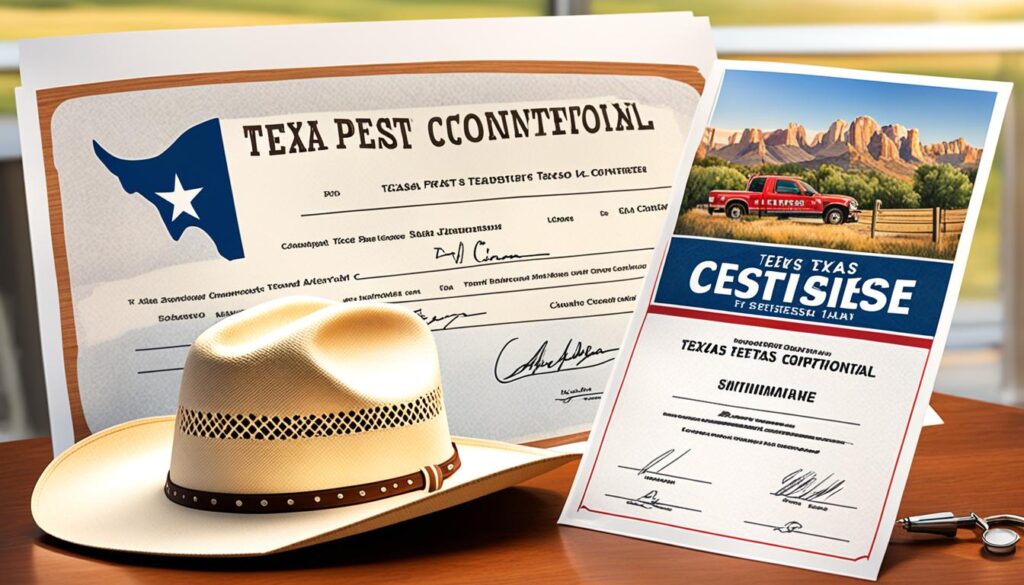The Lone Star State is buzzing with more than just local wildlife; it boasts an impressive number of over 12,000 licensed pest control applicators. If you’ve considered joining this thriving market, understanding how to start a pest control business in Texas is your foundational step. This guide will provide you with indispensable tips for starting a pest control business and help you navigate through the legal tape. So, if setting up a pest control business in Texas is your next entrepreneurial goal, you’re about to get acquainted with the must-know facts that pave the road to your future success.
Key Takeaways:
- Grasping the foundational requirements of the Texas Structural Pest Control Act is crucial for any new pest control business owner.
- Procuring a business license for each location is necessary, in addition to appointing a commercial certified applicator who is solely connected to your business.
- Understanding the strict regulations enforced by the Structural Pest Control Service (SPCS) helps avoid legal pitfalls.
- Preparation and compliance are paramount when advertising and delivering pest control services within Texas.
- These initial considerations set the groundwork for a successful pest control business launch.
Understanding the Texas Pest Control Industry
As you consider launching your own pest control enterprise in the Lone Star State, familiarizing yourself with the texas pest control industry requirements is fundamental to your success. In this portion of your pest control business startup guide, we’ll navigate the regulatory landscape that governs this vibrant industry and explore future market opportunities.
Navigating Regulations and the Structural Pest Control Act
The backbone of the Texas pest control industry is the Structural Pest Control Act. This legislation stipulates that businesses must adhere to strict licensing and certification protocols before they begin operations. Your journey will begin with applying for a business license through the Structural Pest Control Service (SPCS), and it’s essential to keep abreast of any updates to the Act to ensure continued compliance. Key regulations include:
- Appointment of a licensed commercial certified applicator who is responsible for all pest control activities within your business.
- Securing insurance in accordance with the policies outlined by the Texas Occupational Code.
- Ensuring all contracts and agreements feature licensure jurisdiction statements as proof of your adherence to Texas’s regulatory framework.
Meeting these standards will not only solidify the legal foundation of your business but will also enhance its credibility among potential customers.
Growth Projections and Market Opportunities
The demand for pest control services in Texas continues to grow due to factors like urban expansion, climate change, and evolving consumer awareness around health and safety issues associated with pest infestations. This sector promises lucrative growth for well-prepared entrepreneurs. For an effective market entry:
- Analyze regional pest problems and tailor your services to meet those specific needs.
- Become an expert in innovative pest control methods that could set your business apart.
- Explore niche markets such as eco-friendly or organic pest control options that are becoming increasingly popular.
Equipped with knowledge and compliance, your pest control business will be poised to tap into the prospering Texas market and grow steadily alongside it.
Creating Your Pest Control Business Plan
If you’re considering starting a pest control company in Texas, crafting a comprehensive business plan should be your first step. Before you dive into the specifics, it’s important to understand the foundational elements that will guide your venture to success, from identifying your target market to ensuring your plan meets the requirements for a pest control business license in Texas.
Identifying Your Target Market: Residential vs. Commercial
Understanding your potential clientele is crucial for the direction of your services. Will you focus on residential homes, safeguarding families from unwelcome pests, or will you strive to maintain pest-free environments in commercial properties? Perhaps you see a niche in servicing hospitality sectors prone to specific infestations. The choice you make will shape your marketing strategy, service offerings, and operational logistics.
- Gain insights by analyzing the current demand in various sectors within Texas.
- Consider factors such as competition, potential long-term contracts, and seasonality.
- Factor in the specific regulations concerning residential and commercial pest control operations.
Business Plan Essentials for Securing Loans and Investments
To secure the necessary funding for your pest control operation, your business plan must demonstrate viability and profitability to investors or lending institutions. Ensure your plan includes:
- A clear executive summary that encapsulates your company’s vision and goals.
- Detailed financial projections, including start-up costs, recurring expenses, and revenue forecasts.
- Marketing strategies tailored to your identified target market.
- A risk assessment section outlining strategies for potential challenges and market fluctuations.
Remember, your business plan is not only a requirement for obtaining a pest control business license in Texas, but a dynamic blueprint that will keep you aligned with your goals as your business grows.
Choosing the Right Business Structure
When you’re taking the initial steps to establish a pest control business in Texas, one of the most pivotal decisions you’ll face is selecting the legal structure that best fits your enterprise. This choice can significantly influence your liability, taxation, and your capacity to attract investors. Consider your business objectives, the level of control you desire, the degree of legal protection you need, and your willingness to comply with the respective administrative demands of each business type.
LLC, Sole Proprietorship, Partnership, or Corporation?
Each type of business structure—LLC, sole proprietorship, partnership, and corporation—has distinct advantages and disadvantages. A sole proprietorship grants you full control but also implies personal liability for business debts. In contrast, a Limited Liability Company (LLC) offers protection from personal liability and is favored for its flexibility in management and beneficial pass-through taxation.
- Sole Proprietorship: Simple to establish, direct control of operations, with no distinction between personal and business assets for tax and legal purposes.
- Partnership: Shared control and responsibility, beneficial for pooling resources and expertise, but with shared liability among partners.
- Limited Liability Company (LLC): Offers liability protection for personal assets, less formal structure with fewer reporting requirements, and possible tax advantages.
- Corporation: Provides the strongest protection against personal liability and can issue shares to attract investment. However, it faces more stringent regulatory requirements and potentially higher taxes.
The Impact of Business Structure on Taxes and Benefits
Choosing the right structure also has profound tax implications for your pest control business in Texas. An LLC might benefit from pass-through taxation, avoiding double taxation that corporations face, while sole proprietorships and partnerships report business income on personal tax returns. However, a corporation’s ability to carry losses forward and backward might offset its double taxation downside. Additionally, the chosen structure can influence eligibility for small business grants, loans, and other benefits that Texas might offer.
- Analyze potential tax benefits and implications of each business structure.
- Consider the level of paperwork and formalities you’re willing to manage.
- Assess your need for personal asset protection in case of business liabilities.
- Think about your plans for raising capital and the importance of being able to issue stock.
Obtaining the Necessary Pest Control Licenses in Texas
As you embark on establishing a pest control business in the Lone Star State, it’s paramount to navigate through the maze of licensing to ensure full compliance with the Texas standards. Understanding the intricacies of the licensing process will safeguard your business against potential legal issues and establish it as a trusted entity within the industry.

State Licensing Requirements and the Structural Pest Control Service (SPCS)
The journey to legally operate a pest control business in Texas begins with the Structural Pest Control Service (SPCS), a division under the Texas Department of Agriculture. It is crucial for your business to align with the pest control business license Texas regulations that require you to carry appropriate insurance, ensuring both your company’s and your clients’ peace of mind. Don’t overlook the importance of appointing a dedicated certified applicator whose primary responsibility will be to remain accountable for overseeing and directing your business’s pest control activities and compliance.
- Apply for and acquire a pest control business license from the SPCS.
- Ensure proper insurance coverage as per state regulations.
- Designate and maintain a certified applicator for your business.
Distinguishing Between Structural and Agricultural Pest Control Licenses
The scope of your pest control business in Texas will determine the type of license required. If you are focusing on residential and commercial properties, a structural pest control license is mandatory. This license is particular to the management and extermination of pests within and around structures. On the other hand, should your services extend to farms and ranches, addressing the broader landscape, the agricultural pest control license is what you’ll need to legally operate. Recognizing the distinction between these licenses aligns with staying compliant under Texas pest control business regulations and avoids any operational hiccups.
- Determine the type of license your pest control services require.
- Apply for a structural pest control license for structural pest management.
- Opt for an agricultural pest control license for farm and ranch services.
By meticulously following these steps, your Texas pest control business will lay a solid foundation for success, meeting all legal criteria set forth by the Texas Department of Agriculture. Ready your business to thrive by acquiring the pertinent pest control license and staying updated on regulations.
Securing Insurance and Protecting Your Business
When you’re diving into the texas pest control business, understanding and adhering to the texas pest control business regulations is a must, especially when securing the proper insurance to protect your investment. Insurance is not just a legal requirement; it’s your safety net, ensuring that unexpected challenges don’t jeopardize your venture. Let’s break down the essentials to keep you and your business secure.
Minimum Insurance Requirements for Liability Coverage
According to state law, your pest control business needs a minimum insurance coverage of $500,000 per occurrence, which covers both bodily injury and property damage. This requirement is crucial for shielding your business from the financial impacts of potential claims. Remember to aim for a policy that provides a cumulative aggregate of at least $1,000,000 for all incidents, ensuring that you are well-prepared for any sizeable claims that may arise.
Understanding Care, Custody, and Control in Insurance Policies
It’s crucial to grasp the concept of care, custody, and control in insurance policies. As you seek out the optimal insurance for your business, confirm that your policy does not include the care, custody, and control exclusion. Having this coverage is essential; it ensures that when you’re handling clients’ property, you’re protected if damages occur under your supervision. This insight is one of the key tips for starting a pest control business and staying financially secure.
With the right insurance plan, your Texas pest control venture stands on solid ground, prepared to grow and prosper, even when facing the uncertainties that come with any business. Keep these tips in mind as you navigate the regulatory waters and set yourself up for enduring success.
Setting Up Your Pest Control Business Location
When you’re getting your pest control business off the ground in Texas, one crucial step is establishing your physical presence. Whether it’s your main office or additional branch locations, each site plays a pivotal role in both your service delivery and compliance with regulatory bodies. We’ll guide you through the essentials of setting up your business locations, ensuring that you tick all the right boxes from the get-go.
Addressing Branch Offices and Resident Agent Requirements
For those of you starting a pest control company in Texas with multiple service locations, each branch office must be properly licensed. In Texas, this means having all the necessary paperwork in order at your headquarters and at each separate location. Remember, clients put their trust in your ability to operate within the law, so transparency with licensing is non-negotiable.
If your company is based outside the Lone Star State but you’re planning to offer services within it, you’ll need to appoint a resident agent in Texas. This agent acts as a liaison for any legal notices or governmental correspondence, ensuring you’re always in the loop and responsive to the state’s requirements.
The Importance of Registered Business Addresses
Getting your address details right isn’t just about receiving mail; it’s a regulatory requirement. Ensure that your registered business address is accurate and communicated to the Structural Pest Control Service (SPCS) within ten days of any changes. This swift action is not only compliant but also fosters a reputation for reliability and professionalism—both crucial when setting up a pest control business in Texas.

- Ensure each branch office is licensed and compliant with Texas pest control regulations.
- Maintain transparent communication with the SPCS about your business locations.
- Appoint and provide details of a resident agent if your company headquarters are outside of Texas.
By paying close attention to these critical steps, your journey into the pest control industry will be both smooth and compliant, laying a strong foundation for your business’s future successes.
Complying with Tax ID and Business Licenses
If you’re delving into how to start a pest control business in Texas, understanding the specifics of Texas pest control business regulations is critical. An integral component of setting up your business involves getting your tax identification affairs in order. Here’s what you need to know regarding Taxpayer Identification Number (TIN) and staying updated with your business licenses.
Applying for a Taxpayer Identification Number
One of the first steps in establishing your pest control enterprise in the Lone Star State is to obtain a Taxpayer Identification Number (TIN). This number not only serves as your business’s tax identifier but is also essential for your business license application. Without it, your business lacks an official tax status, which could lead to compliance issues down the line.
Updating Business Licenses with Tax ID Changes
Keep in mind that any changes to your business’s structure or ownership could result in a change to your TIN. In such cases, you’re obligated to seek a new business license that reflects these changes. It’s a process that ensures your business stays on the right side of tax and licensing regulations—hallmarks of credibility and professionalism in the bustling Texas pest control industry.
- Contact the IRS to apply for a Taxpayer Identification Number.
- Ensure your business license details mirror your current TIN.
- Regularly review your tax status in case of business amendments that impact your TIN.
Embrace diligence in tax and licensing to augment the success of your pest control business in Texas, as these elements play a pivotal role in operational legitimacy.
Assembling Your Team and Registering Employees
As you embark on the essential steps to establish a pest control business in Texas, it’s imperative to build a solid team that will uphold the quality and reputation of your company. A pivotal aspect of this process entails hiring certified applicators and technicians, ensuring that your staff consists of trained professionals who meet the state’s stringent criteria for pest management. Moreover, the composition of your workforce will significantly contribute to the operational success of your pest control company in Texas.
Hiring Certified Applicators and Technicians
As you delve into starting a pest control company in Texas, it’s paramount to attract and hire individuals who are not only qualified but also certified as pest control applicators or technicians. This ensures your business operates with a team capable of addressing the variety of pest management challenges you will encounter. Each member must bring a level of expertise and professionalism to your service offerings, reinforcing client confidence and business integrity.
Employee Registration and Termination Protocols
Once you’ve selected your team, Texas law stipulates a timely registration of all employees with the Texas Department of Agriculture. This is a critical compliance step: you must complete employee registration within ten days following their hiring to avoid potential fines or disruptions. Additionally, should you part ways with an employee, familiarize yourself with termination protocols to maintain legal and professional standards within your pest control business practices.
FAQ
How do I start a pest control business in Texas?
What regulations must I adhere to in the Texas pest control industry?
What should I include in my pest control business plan for Texas?
How do I choose the best business structure for my Texas pest control company?
What licenses are required for a pest control business in Texas?
What are the insurance requirements for a pest control business in Texas?
FAQ
How do I start a pest control business in Texas?
To start a pest control business in Texas, you need to understand and comply with the Structural Pest Control Act, secure a business license from the Structural Pest Control Service (SPCS), appoint a certified applicator, and plan your business model. Additionally, you’ll need to choose a business structure, obtain the required insurance, set up your business location, comply with tax ID and business licensing requirements, and assemble a qualified team.
What regulations must I adhere to in the Texas pest control industry?
You must follow the Structural Pest Control Act, which mandates licensing and certification to engage in pest control activities, including ensuring you have a commercial certified applicator, adequate insurance according to the Texas Occupational Code, and proper licensure statements on contracts.
What should I include in my pest control business plan for Texas?
Your business plan should define your target market, establish operational strategies, and provide financial projections. This plan is crucial for guiding your business decisions and securing loans or investments.
How do I choose the best business structure for my Texas pest control company?
Consider factors like liability, taxation, and operational needs when choosing between an LLC, sole proprietorship, partnership, or corporation. Each has different implications for asset protection and tax treatment.
What licenses are required for a pest control business in Texas?
You need to acquire a structural pest control business license from the SPCS, carry suitable insurance, and ensure your business is led by a certified applicator to maintain compliance with state regulations.
What are the insurance requirements for a pest control business in Texas?
You must obtain liability insurance with a minimum of 0,000 per occurrence for bodily injury and property damage, with a
FAQ
How do I start a pest control business in Texas?
To start a pest control business in Texas, you need to understand and comply with the Structural Pest Control Act, secure a business license from the Structural Pest Control Service (SPCS), appoint a certified applicator, and plan your business model. Additionally, you’ll need to choose a business structure, obtain the required insurance, set up your business location, comply with tax ID and business licensing requirements, and assemble a qualified team.
What regulations must I adhere to in the Texas pest control industry?
You must follow the Structural Pest Control Act, which mandates licensing and certification to engage in pest control activities, including ensuring you have a commercial certified applicator, adequate insurance according to the Texas Occupational Code, and proper licensure statements on contracts.
What should I include in my pest control business plan for Texas?
Your business plan should define your target market, establish operational strategies, and provide financial projections. This plan is crucial for guiding your business decisions and securing loans or investments.
How do I choose the best business structure for my Texas pest control company?
Consider factors like liability, taxation, and operational needs when choosing between an LLC, sole proprietorship, partnership, or corporation. Each has different implications for asset protection and tax treatment.
What licenses are required for a pest control business in Texas?
You need to acquire a structural pest control business license from the SPCS, carry suitable insurance, and ensure your business is led by a certified applicator to maintain compliance with state regulations.
What are the insurance requirements for a pest control business in Texas?
You must obtain liability insurance with a minimum of $500,000 per occurrence for bodily injury and property damage, with a $1,000,000 aggregate limit, and ensure that the policy complies with state requirements by excluding the care, custody, and control exclusion.
How do I set up my pest control business location in Texas?
Each branch office must be licensed, and if you’re operating from outside Texas, a resident agent must be appointed. Always keep registered business addresses up to date with the SPCS.
What do I need to know about Tax ID and business licenses in Texas?
Obtain a Taxpayer Identification Number for your business and ensure any changes to this number are reflected in your business license application. If there are changes in your business structure or ownership, you’ll need to apply for a new business license.
What should I consider when hiring employees for my pest control business?
Hire qualified employees, including certified applicators and technicians, and make sure they are registered with your business license within ten days of hiring. Be aware of protocols for termination and ensure your staff meets the standards set by the SPCS.
,000,000 aggregate limit, and ensure that the policy complies with state requirements by excluding the care, custody, and control exclusion.
How do I set up my pest control business location in Texas?
Each branch office must be licensed, and if you’re operating from outside Texas, a resident agent must be appointed. Always keep registered business addresses up to date with the SPCS.
What do I need to know about Tax ID and business licenses in Texas?
Obtain a Taxpayer Identification Number for your business and ensure any changes to this number are reflected in your business license application. If there are changes in your business structure or ownership, you’ll need to apply for a new business license.
What should I consider when hiring employees for my pest control business?
Hire qualified employees, including certified applicators and technicians, and make sure they are registered with your business license within ten days of hiring. Be aware of protocols for termination and ensure your staff meets the standards set by the SPCS.




